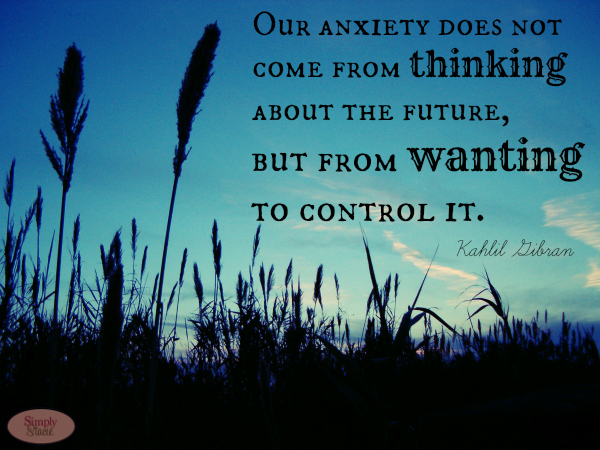Full Disclosure: Clicking on these links could mean a tiny commission for me, at no extra cost to you.
As I have mentioned throughout a variety of my anxiety blog posts, determining what is anxiety can’t be done from reading one sentence, as it is different for every single person. Everyone has different panic attack symptoms and situations that cause their nerves to be heightened.
The majority of you should be able to fall within one of the categories below, in order to determine the type of anxiety that you have. I also want you to know that you don’t need medication! Take the time to Learn about how to help common conditions & ailments using natural methods at our Health A-Z Index!
Generalized Anxiety Disorder
Also known as GAD, this is the most common form of panic attacks. It is best described as an ongoing state of mental and/or physical nervousness. Sometimes it is brought on by a cause, and sometimes without. Generalized anxiety disorder, or GAD, is the most common and widespread type of anxiety. GAD affect tens of millions of people throughout the world.
GAD is best described as an ongoing state of mental and/or physical tension and nervousness, either without a specific cause or without the ability to take a break from the anxiety.
People who suffer from GAD tend to have a constant feeling of worry, stress and nervousness to the point that it disrupts your daily life.
Social Anxiety
This kind of anxiety is brought on my social situations. You have an irrational fear of being in situations with other people, whether it be a public place, party, speaking in front of people, or anything that involves you being around others.
Being nervous in some of these situations is very common. However, it becomes a social phobia when it disrupts your life, and you start to avoid specific situations.
Panic Disorder
Panic disorder is when you experience intense feelings of doom, death or something awful happening. The fear is so irrational that you may find yourself becoming hospitalized. It’s somewhat similar to being an extreme hypochondriac.
You are so severely worried and stressed that something is wrong with you physically or mentally.
Agoraphobia
This kind of anxiety is about the fear of going out in public, whether it is the fear of open spaces or being in places and situations that are unfamiliar. You avoid any situation that takes you out of the comfort of your home, and will come up with endless excuses to not travel outside.
Although not always, many people who suffer from agoraphobia also have panic disorder.
Specific Phobia
Anxiety that is brought on by specific situations, animals, objects or scenarios are specific phobia driven. A fear of spiders or heights is so intense that you physically and mentally go into panic mode.
Although the fear of such things may be common, it is the way that your body reacts that sets you apart from the typical feelings of fear.
Post Traumatic Stress Disorder (PTSD)
PSTD is often associated with people who have returned from overseas, or who are now retired veterans. However, anyone who has suffered from a life trauma, whether physically or emotionally, can suffer from Post Traumatic Stress Disorder. As the name reads, it is anxiety about something that you have experienced previously.
You may have night tremors, flashbacks or relive the trauma when suffering from PSTD.
Obsessive Compulsive Disorder (OCD)
Obsessive compulsive disorder, or OCD, consists of having intense behaviours and fears that are irrational and odd. ROCD is also a common form of OCD that is coming to the limelight of mental disorders. You do something repetitively, and can’t seem to function unless you do so.
For example, washing your hands consistently, constantly, an abnormal amount of times.
This anxiety blog will explore what is anxiety for each specific disorder.
Phobia-Specific Anxiety
According to Anxiety and Depression Association of America, 19 million Americans suffering specific phobias. These people often avoid different situations, places, objects, or people for fear of danger or something and happening, despite there being no threat. Some common phobias include:
- Coulrophobia (Excessive fear and worry about clowns)
- Islamphobia (Irrational fear of all muslims)
- Agoraphobia (Fear of leaving your house)
- Arachnophobia: Fear of spiders
- Acrophobia: Fear of heights
- Claustrophobia: Fear of closed spaces
- Mysophobia: Fear of germs
People use these terms all the time, even when they don’t apply. When something is a phobia, it’s debilitating and it interferes with your life. Most phobias are caused from trauma experienced with that specific item or situation. For example, no one likes spiders and some of us even avoid them but that doesn’t mean you’re an arachnophobia.
Separation Anxiety
Separation Anxiety is when someone experiences intense levels of distress when separated from a loved one, caregiver, pet, etc. The stress is so extreme that they’re unable to function and live a normal life without that someone. Some children experience this with their parents, some animals experience it with their owners, some adults experience it with their loved ones, and rarely but in some cases, adults do develop separation anxiety.
Illness Anxiety
Often referred to as Hypochondria, illness anxiety disorder pertains to the excessive worry about being ill or sick. Even after various medical tests and proof that one isn’t ill, someone suffering from this type of anxiety still believes they are becoming ill. Often times, this intense level of anxiety can lead them to becoming sick or showing signs of illness, despite having good health.












